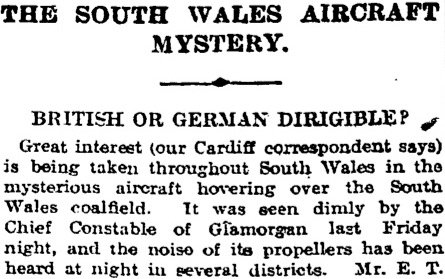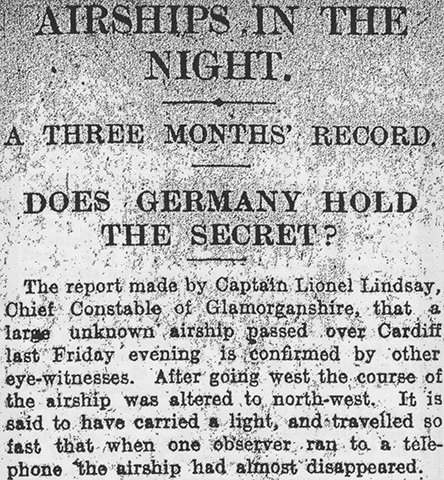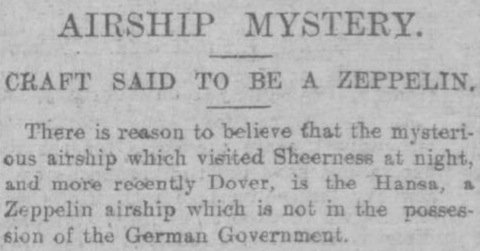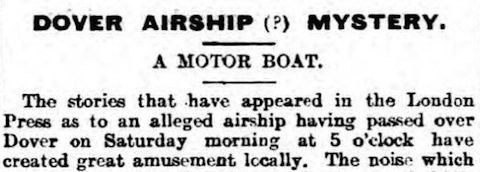
The Dublin Irish Times has a report (p. 9; above) of a 'mysterious airship' seen on last Wednesday, 8 January 1913, at Newport, Co. Mayo, on the northwest coast of Ireland. It was first seen at 6.40pm to the southwest, and looked 'at first' like 'a very large, bright star'. It shortly 'was seen to move slightly to and fro, and at times was surrounded by a kind of luminous haze, such as is formed when strong light falls on smoke or vapour'.
It then occurred to those who were watching it that the light belonged to some airship, probably a dirigible, and that the haze was caused by vapour from the engine being blown across the path of the light. It seemed as if the airship was trying to approach the lights of the town, but was unable to do so owing to the strong easterly wind that was blowing. Many recalled the airship that was said to have flown over Sheerness some time ago, and the word 'Germans' was heard pretty often.
The light seemed to be 'about two miles distant, over the sea, and at an elevation of between 500 and 1,000 feet'. Some people 'affirmed that they distinctly heard the whirr of propellers'. It remained visible in 'nearly the same position' for about an hour, 'seemingly struggling against the wind, and considerable excitement prevailed among the crowd of onlookers'. At 7.50pm 'the airmen seemed to have abandoned the attempt to reach Newport in the face of the wind', because the light 'suddenly' moved southwest and then disappeared. Two or three policemen were among the witnesses, having been alerted shortly after the airship was first seen; after it had gone Sergeant Padian, RIC, telegraphed 'the police of Westport, etc.' to look out for it but without result. Since 'the easterly wind increased to a gale during the night, it was thought that they [the airmen] had been blown out to sea'.
Flight has taken notice of the airship seen at Dover, though it's almost the last item in today's issue, tucked in with a few miscellaneous announcements between the letters column and the subscription rates on p. 52:
YET again the throb of an aerial motor and the whirr of a propeller has been heard during the hours when most worthy citizens are abed. This time the mysterious aircraft was heard at Dover at 5 a.m. on the 5th inst., but it was not unlikely an aviator from a flying ground, not a hundred miles from Dover, out for a very early spin. No doubt if aviation progresses as rapidly in the future as it has done in the past it will not be long before episodes such as this will be deemed just in the day's or night's events.
The first and least interesting thing to note here is that the date is given as 5 January, when most accounts have 4 January. The second and almost as uninteresting thing is the allusion to a previous sighting(s). This would seem to be a reference to the Sheerness Incident, except that took place in the early evening, not 'during the hours when most worthy citizens are abed'. The third and most interesting thing is that like the Dover Express, Flight thinks there is nothing in this sighting, though it pins the blame on a British aeroplane rather than a British motorboat. However both explanations rely on the general unfamiliarity of the public with aircraft. On the other hand, the Newport sighting, with the inference drawn by onlookers that the light from the airship was being seen through the exhaust from the engine, seems to suggest that people knew what to expect when looking at aircraft in flight; or rather that they thought they knew.
Otherwise the only other phantom airship mention today is a tiny summary of the Dover sighting in the Tamworth Herald, p. 5.







